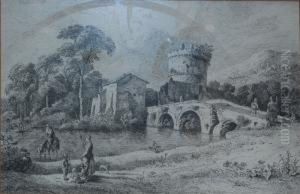Isaac Weissenbruch Paintings
Johan Hendrik Weissenbruch, often known as Jan Hendrik or Hendrik Johannes Weissenbruch, was a prominent Dutch landscape painter and a master of the Hague School, born on June 19, 1826, in The Hague, Netherlands. He was part of a movement that sought to capture the everyday beauty of the Dutch countryside, characterized by its realistic portrayal of life and nature.
From a young age, Weissenbruch showed an affinity for art, and he began his formal training at the age of sixteen at the Royal Academy of Art in The Hague, where he studied under the tutelage of Johannes Low, Bartholomeus Johannes van Hove, and Andreas Schelfhout. These instructors, especially Schelfhout, were influential in shaping his early style, which was traditionally focused on Dutch scenery like dunes, forests, and waterways.
Weissenbruch's work is noted for its innovative approach to light and atmosphere. He often depicted the flat, polder landscapes under cloudy skies, where the interplay of light and shadow was a central theme. His paintings were characterized by a skilled use of color and a preference for dynamic, unsettled weather conditions, which he felt added emotion and drama to his work.
Throughout his career, Weissenbruch experimented with various techniques and was not afraid to blend the boundaries between realism and impressionism. He was particularly adept at watercolors, a medium through which he expressed a great deal of spontaneity and fluidity. His later works, in particular, show a tendency towards a looser, more impressionistic style, a departure from the finely detailed works of his earlier years.
Weissenbruch was a member of various artist societies, including the Pulchri Studio in The Hague and Arti et Amicitiae in Amsterdam. His work was well-received during his lifetime, and he exhibited widely, both in the Netherlands and abroad. Today, his paintings can be found in significant public collections, including the Rijksmuseum in Amsterdam and the Gemeentemuseum Den Haag.
Hendrik Johannes Weissenbruch passed away on March 24, 1912, in his hometown of The Hague. His legacy lives on as one of the leading figures of the Hague School, and his contributions to the development of Dutch landscape painting continue to be celebrated. His ability to capture the essence of the Dutch landscape with such vibrancy and emotional depth has secured his position as a significant artist in the history of Dutch art.
